All I know about triremes comes from Wikipedia these days.
http://en.wikipedia.org/wiki/Trireme
Plato’s Republic opens with Socrates walking from Piraeus to Athens. He visited Piraeus to see a religious ritual. That is what theorists do: observe. On that note please see the street name below near the Acropolis. I have explained the meaning of the word “theory” elsewhere in the blog. Seek and ye shall find.
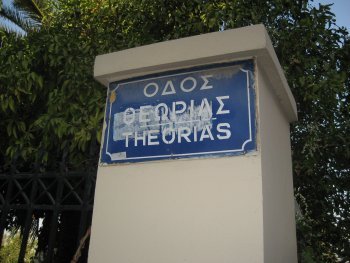
I particularly wanted to go to Piraeus to see the foundations of some ancient ship sheds which the guide books say are still visible. Yet another relic spanning the millenia.
Moreover, when I researched Piraeus I found there were two museums there. The nautical museum of Greece and an archaeological museum. Those two together with the ancient ship sheds would more be more than enough for us.
The Hellenic Maritime Museum is found at http://www.greece-museums.com/museum/26/
For the Archaeological Museum of Piraeus see http://www.greeklandscapes.com/greece/piraeus/
So off we went one fine day. We took the metro rather than walk in the Socratic fashion. As usual we waited on the platform no time at all and boarded the red line train (built at the end of the 19th Century) and six stops later were disembarked in Piraeus.
It is a sizeable harbour and is as worn and greasy as seaports are. And busy! We found navigating difficult since my street map did not cover Piraeus we had to work with the more schematic maps in the back of the tour guide books. We had some error that proved trying but we made it.
We walked by the Archaeological Museum without recognizing it the first time. We were getting so inured to ruins that its courtyard, which is visible from the street, with its ruins did not register fully on us. However, we did figure it out, and ascended the steps we found it to be closed for renovations. Hmm.
We also had trouble finding the Martime Museum because of the schematic map, and asking locals, even some who were clearly in naval uniforms meant with rebuff, silence, and misdirection. It was the language barrier. Yet we persevered and found it.
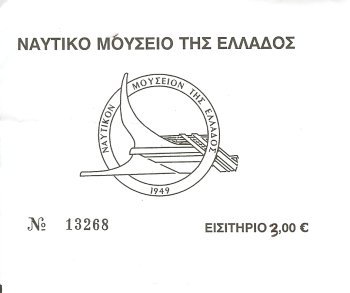
It is a nice place, well integrated into the surroundings, and unmistakable from the front, but we pedestrians do not approach it from the front.
Upon entry there is a map of the homeward voyage of Odysseus. Nice. It looked something like this.
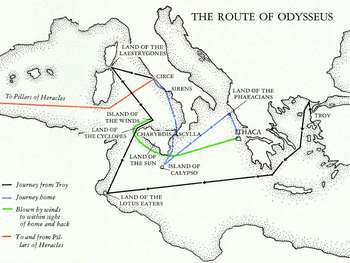
I had hoped to find here some details about the evolution of the trireme, all the more so since I did not find such information at the War Museum. Here as there I found models of triremes, but nothing about its evolution. Or even simpler questions, like where did the wood come from? Yet it would have been the technological marvel of its age. Why?
It had a large payload, it was manoeuvrable, and it was fast. The Athenian Empire was made of oak, just as the British Empire was two thousand ears later, in these ships. These ships meant Athens could defeat Persia and match Sparta for twenty-seven years.
Trireme as I might, I found no insight into the development of this technology, but plenty of cute models of triremes.
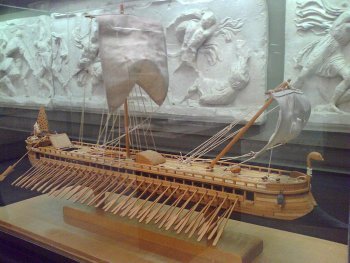
Athens built hundreds of these craft as both war ships and merchant marine. It kept building them apace even at the end of the war when its treasure and manpower were depleted, yet somehow it kept building them, rather as Nazi Germany kept building airplanes ever faster even though all its pilots were dead and despite the Allied bombing of war industries. When an Athenian fleet was sunk, new triremes were built so fast as repeatedly to surprise and confound Sparta and its silent partner toward the end (that is code for Persia).
The Hellenic Maritime Museum has much more about Greece and the sea, and in particular a lot about conflict with the ancient enemy – Turkey.
We found the remains of the foundations of ship sheds on the inner harbour. By the way see http://www.zeaharbourproject.dk/3/3_09.htm.
The ship sheds would have looked something like this, an ancient dry dock.
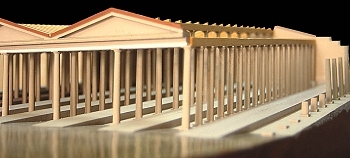
The ruins are beneath an apartment building. We found the street and sure enough through the windows at ground level we saw remains from 2,500 years ago. I took pictures with my digital camera pressed to the glass of the windows with the flash off.
This plaque is on the wall of the building of the building.
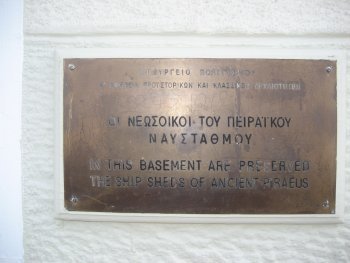
This is perhaps the best shot because it shows one of the stones illuminated in the back.
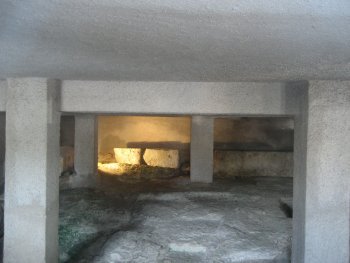
Nicias, Pericles, Diodotus and others would have been here more than once.
The building is on a busy street choked with traffic and across the road is an esplanade, moored along it is one multi-million dollar pleasure craft after another with names like Odyseuss, Calypso, Argo, Circe, and many others.
We walked around Piraeus to make our way back to Faliro Station through parks which might well have been the sites of the rituals Socrates observed. And no sooner did we make it to the platform than a train appeared and off we went.
The triremes are important enough to figure on the wall of the National Parliament in Syntagma Square.
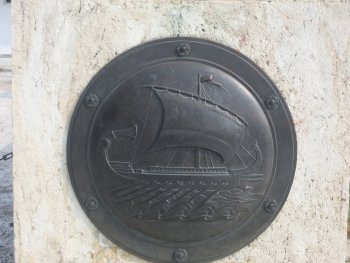
But the ship pictured here is in fact not a trireme. Curious.
Nowhere in Piraeus, nor in my research, did I find anything about the Periclean Wall that linked the Zea Harbor and the Acropolis. This wall was built after the Themistoclean Wall and lasted through the Great War with Sparta. Both walls were dismantled on Persian orders by the Spartans, yet much of the latter remains and evidenlty nothing of the former.

Do you know where the Olympia (the full size trireme) is docked or exhibited and how and when one can see it?
Sid,
I am afraid I do not know. Michael